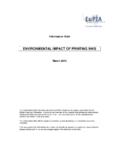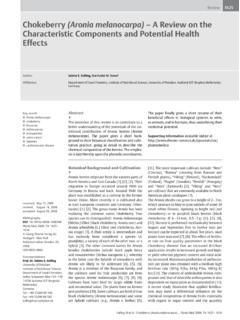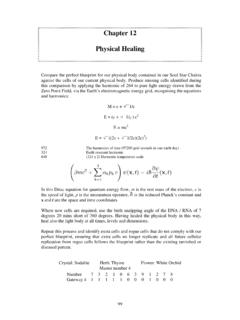Transcription of OECD GUIDELINE FOR THE TESTING OF CHEMICALS
1 TG/Administrators/Jukka/Plant tests/208sept03_draft 1/19 DRAFT DOCUMENT September 2003 OECD GUIDELINE FOR THE TESTING OF CHEMICALS PROPOSAL FOR UPDATING GUIDELINE 208 Terrestrial Plant Test: 208: Seedling Emergence and Seedling Growth Test INTRODUCTION 1. OECD Guidelines for the TESTING of CHEMICALS are periodically reviewed in the light of scientific progress and current regulatory procedures. This updated GUIDELINE is designed to assess potential effects of substances on seedling emergence and growth. As such it does not cover chronic effects or effects on reproduction ( seed set, flower formation, fruit maturation). Conditions of exposure and properties of the substance to be tested must be considered to ensure that appropriate test methods and test substance levels are used ( when TESTING metals/metal compounds the effects of pH and associated counter ions should be considered)(1).
2 This GUIDELINE does not address plants exposed to vapours of CHEMICALS . The GUIDELINE is applicable to the TESTING of both general CHEMICALS and crop protection products (also known as plant protection products or pesticides). It is based upon existing methods (2) (3) (4) (5) (6) (7) (8). Other references pertinent to plant TESTING were also considered (9) (10) (11). Definitions used are given in Annex 1. PRINCIPLE OF THE TEST 2. The test assesses effects on seedling emergence and early growth of higher plants following exposure to the test substance in the soil (or other suitable matrix). Seeds are placed in contact with soil treated with the test substance and evaluated for effects following 14 to 21 days after 50% emergence of the seedlings in the control group. Endpoints measured are visual assessment of seedling emergence, biomass (fresh or dry shoot weight, or shoot height) and visual detrimental effects (chlorosis, mortality, plant development abnormalities, etc.)
3 Measurements are made at least weekly or more often when recording the emergence of the seeds and compared to those of untreated control plants. 3. The seedling emergence and growth test is intended to meet TESTING requirements for both general CHEMICALS and crop protection products. Depending on the expected route of exposure, the test substance is either incorporated into the soil (or artificial soil matrix) or applied to the soil surface, which properly represents the potential route of exposure. In the case of soil incorporation, the soil is transferred to pots after treatment and seeds of the given plant species are then planted. Surface applications are made to potted soil in which the seeds have already been planted. The test units (controls and treated soils plus seeds) are then placed under appropriate conditions to support germination/growth of plants. Optionally, the test can be extended to combine both soil exposure and further foliar exposure as in the test GUIDELINE 227 (12).
4 4. The test can be conducted at a single concentration/rate as a limit test according to the aim of the study or to determine if further TESTING ( a dose-response test) was warranted. If results from the single rate test exceed a certain phytotoxicity level ( whether effects greater than x% are observed), multiple TG/Administrators/Jukka/Plant tests/208sept03_draft 2/19 rate TESTING preceded by range-finding test(s) is conducted to generate a dose-response curve using appropriate statistical analysis to obtain an ECx for the most sensitive parameter(s), where x is the % effect level. INFORMATION ON THE TEST SUBSTANCE 5. The following information is useful in designing the test: structural formula, purity, water solubility, solubility in organic solvents, n-octanol/water partition coefficient, soil sorption behaviour, vapour pressure, chemical stability in water and light, and biodegradability.
5 This GUIDELINE may need to be modified to accommodate highly volatile substances, to eliminate possible cross contamination by using separate growing chambers or other adequate means. 6. The substance must be applied in an appropriate carrier ( water, acetone, ethanol, polyethylene glycol, gum Arabic, sand). Crop protection products are tested as final preparations intended for registration or in certain cases as representative formulation. VALIDITY OF THE TEST 7. In order for the test to be considered valid, the following performance criteria must be met in the controls: - the seedling emergence should be at least 80% for crop and 65 % for non-crop species; - the mean control seedling growth does not exhibit visible phytotoxic effects ( chlorosis, necrosis, wilting, leaf and stem deformation); - the mean control survival is at least 90% for the duration of the study; - for any species, all organisms in a test must be from the same source; - all test chambers or rooms used for a particular species should be identical and should have same conditions and contain same amount of soil matrix, support media, or substrate from the same source.
6 REFERENCE SUBSTANCE 8. A reference substance could be tested either at regular intervals or possibly included in each test to verify that performance of the test and the response of the test plants has not changed significantly over time. Suitable reference substances for example for certain species can be found in Annex 5 or in (13). DESCRIPTION OF THE METHOD Soil - Artificial Substrate 9. Plants may be grown in pots using a sandy loam, loamy sand, or sandy clay loam soil that contains up to percent organic carbon. Commercial potting soil or synthetic soil mixes may be used as the soil medium . Clay soils should not be used if the test substance is known to have a high affinity for clays. Field soil should be sieved to remove coarse particles greater than those which will pass through a 2 mm screen. Soil type and texture, % organic carbon and pH should be reported. The soil should be classified according to a standard classification scheme (14).
7 Pasteurized or heat treated soil could be used to reduce the effect of soil pathogens. TG/Administrators/Jukka/Plant tests/208sept03_draft 3/19 10. Natural soil could complicate interpretation of results and increase variability due to varying physical/chemical properties and microbial populations. These variables in turn alter moisture-holding capacity, chemical-binding capacity, aeration, and nutrient and trace element content. In addition to the variations in these physical factors, there will also be variation in chemical properties such as pH and redox potential, which may affect the bioavailability of the test substance (15) (16) (17). 11. Glass beads, mineral wool, and 100 percent acid washed sand (with nutrient solution added) are usually not recommended for TESTING of crop protection products, however they may be of use for the TESTING of general CHEMICALS or where it is desired to minimize the variability of the natural soils.
8 Growth support media or substrates used should be composed of inert materials that minimize interaction with the test substance, the solvent carrier, or both. Quartz sand and glass beads ( , to mm in diameter) have been found to be suitable inert materials that minimally absorb the test substance (18), ensuring that the substance will be maximally available to the seedling via root uptake. Unsuitable substrates would include vermiculite, perlite or other highly absorptive materials. Nutrients for plant growth should be provided to ensure that plants are not stressed through nutrient deficiencies, and where possible this should be assessed via chemical analysis or by visual assessment of control plants. Selection and number of test species 12. The selection of species should be based on the ecological relevance of species, species specific life-cycle characteristics, region of natural occurrence etc.
9 (9) (19) (20) (21) (22) (23). The following characteristics of the possible test species should be considered in the selection: accessibility to characterized test species, plant is amenable to TESTING in the laboratory, and reproducibility within and across TESTING facilities, plant uniformity, their distribution, abundance and taxonomic representation suggest broad coverage of the plant kingdom, they are sensitive to many toxic compounds and have been used to some extent in previous bioassays (their use in herbicide bioassays, heavy metal screening, salinity and mineral stress tests and allelopathy studies indicates sensitivity to a wide variety of stressors), and they are compatible with the environmental growth conditions and time constraints of the test method; they meet the performance criteria of the test Some of the historically most used test species are listed in Annex 2 and potential non-crop species in Annex 3.
10 13. The number of species for use in this GUIDELINE should comply with the relevant regulatory requirements. TG/Administrators/Jukka/Plant tests/208sept03_draft 4/19 Application of the test substance Incorporation into soil/artificial substrate 14. Substances which are water soluble or suspended in water, can be added to water and the test solution then mixed with soil. This type of test may be appropriate if exposure to the chemical is through soil or soil pore-water and that there is concern for root uptake. The water-holding capacity of the soil should not be exceeded by the addition of the test substance. The volume of water added should be the same for each test concentration, but should be limited to prevent soil agglomerate clumping. 15. Substances with low water solubility should be dissolved in a suitable volatile solvent ( acetone, ethanol) and mixed with sand.


















